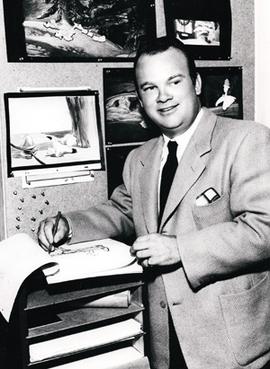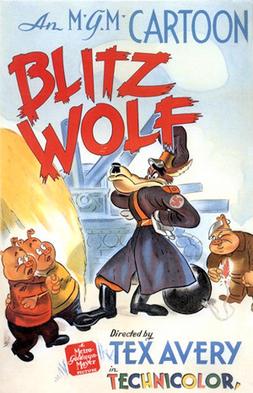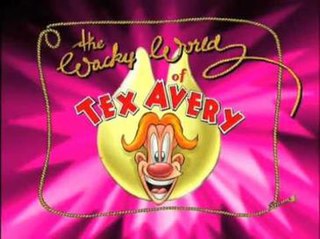Related Research Articles

Frederick Bean "Tex" Avery was an American animator, cartoonist, director, and voice actor. He was known for directing and producing animated cartoons during the golden age of American animation. His most significant work was for the Warner Bros. and Metro-Goldwyn-Mayer studios, where he was crucial in the creation and evolution of famous animated characters such as Bugs Bunny, Daffy Duck, Porky Pig, Elmer Fudd, Droopy, Screwy Squirrel, The Wolf, Red Hot Riding Hood, and George and Junior.

The golden age of American animation was a period in the history of U.S. animation that began with the popularization of sound synchronized cartoons in 1928 and gradually ended in the 1960s when theatrical animated shorts started to lose popularity to the newer medium of television. Animated media from after the golden age, especially on television, were produced on cheaper budgets and with more limited techniques between the 1960s and 1980s.

Droopy is an animated character from the golden age of American animation. He is an anthropomorphic white Basset Hound with a droopy face; hence his name. He was created in 1943 by Tex Avery for theatrical cartoon shorts produced by the Metro-Goldwyn-Mayer cartoon studio. Essentially the polar opposite of Avery's other MGM character, the loud and wacky Screwy Squirrel, Droopy moves slowly and lethargically, speaks in a jowly monotone voice, and—though hardly an imposing character—is shrewd enough to outwit his enemies. When finally roused to anger, often by a bad guy laughing heartily at him, Droopy is capable of beating adversaries many times his size with a comical thrashing.

Barney Bear is an American series of animated cartoon short subjects produced by MGM Cartoons. The title character is an anthropomorphic cartoon character, a sluggish, sleepy bear who often is in pursuit of nothing except for peace and quiet. 26 cartoons were produced between 1939 and 1954.

The Heckling Hare is a Merrie Melodies cartoon, released on July 5, 1941, and featuring Bugs Bunny and a dopey dog named Willoughby. The cartoon was directed by Tex Avery, written by Michael Maltese, animated by soon-to-be director Robert McKimson, and with musical direction by Carl W. Stalling. In a style that was becoming typical of the Bugs character, he easily outwitted and tormented his antagonist through the short, his only concern being what to do next to the dog.

The Tex Avery Show is an American animated showcase series of Metro-Goldwyn-Mayer and Warner Bros. cartoon shorts prominently by animator Tex Avery. In between the shorts, Don Kennedy gives short facts about the cartoons. The showcase premiered on the Cartoon Network in 1996, and was taken off the air in 2002, while reruns continued to be shown on Cartoon Network until April 11, 2004. It was soon re-broadcast on Boomerang.
Preston Erwin Blair was an American character animator, best remembered for his work at Walt Disney Productions and the Metro-Goldwyn-Mayer cartoon studio.
Ed Benedict was an American animator and layout artist. He is best known for his work with Hanna-Barbera Productions, where he helped design Fred Flintstone, Yogi Bear, and Huckleberry Hound.

Thugs with Dirty Mugs is a 1939 Warner Bros. Merrie Melodies cartoon directed by Tex Avery. The short was released on May 6, 1939.

The Metro-Goldwyn-Mayer cartoon studio was an American animation studio operated by Metro-Goldwyn-Mayer (MGM) during the Golden Age of American animation. Active from 1937 until 1957, the studio was responsible for producing animated shorts to accompany MGM feature films in Loew's Theaters, which included popular cartoon characters Tom, Jerry, Droopy, Butch, Spike, Tyke, and Barney Bear.
Michael Richard Lah was an American animator of Slovene origin. He is best remembered for his work at the Metro-Goldwyn-Mayer cartoon studio, primarily as a member of Tex Avery's animation unit. He first worked on Tom and Jerry shorts before going to work on Droopy/Tex Avery shorts.

Blitz Wolf is a 1942 American animated propaganda short film produced and distributed by Metro-Goldwyn-Mayer. A parody of the Three Little Pigs told via a World War II perspective, the short was directed by Tex Avery and produced by Fred Quimby. It was nominated for the Academy Award for Best Short Subject: Cartoons but lost to Der Fuehrer's Face, another anti-Nazi World War II parody featuring Donald Duck.
Irven LeRoy Spence was an American animator. He is best known for his work on MGM's Tom and Jerry animated shorts. Spence has been credited variously as Irven Spence, Irvin Spence, and Irv Spence.

The Wacky World of Tex Avery is an animated television series created by Robby London and co-produced by DIC Productions, L.P., Les Studios Tex SARL, Milimetros, M6 and Telcima.

Bad Luck Blackie is a 1949 American animated comedy short film produced by Metro-Goldwyn-Mayer.

Northwest Hounded Police is a 1946 American animated short film directed by Tex Avery, produced by Fred Quimby, and featuring Droopy and Avery's wolf character. A remake of Droopy's first cartoon Dumb-Hounded, the short revolves around the wolf on the run from Droopy, who is trailing the wolf in order to capture him. The title is a play on words on the film North West Mounted Police (1940).
Little Rural Riding Hood is a 1949 MGM animated cartoon short subject directed by Tex Avery, conceived as a follow-up to his 1943 cartoon Red Hot Riding Hood.

Gilbert H. Turner was an American animator, comic book artist and producer.
Tex Avery Screwball Classics is a series of single-disc Blu-ray and DVD sets by Warner Bros. Home Entertainment's Warner Archive unit collecting various theatrical cartoons from animation director Tex Avery during his tenure at the Metro-Goldwyn-Mayer studio's cartoon division between the years of 1942 and 1955. It is the first comprehensive collection of Avery's MGM shorts to be released on home media in North America since The Compleat Tex Avery series of laserdiscs in the 1990s, with many of the shorts having been previously unreleased on DVD or Blu-ray.
References
- ↑ Lenburg, Jeff (1999). The Encyclopedia of Animated Cartoons. Checkmark Books. pp. 146–147. ISBN 0-8160-3831-7.
- ↑ “Pretty Long Wait, Wasn’t It?”: TEX AVERY’S VOICE ACTORS (Volume 3)
- ↑ Don Markstein's Toonpedia: Tex Avery
- ↑ Tex Avery: King of Cartoons (Documentary). Turner Entertainment. 1988. Event occurs at 43:00-44:14.
- ↑ Of Fords And Fritos: Animation's Forgotten Ad Studios